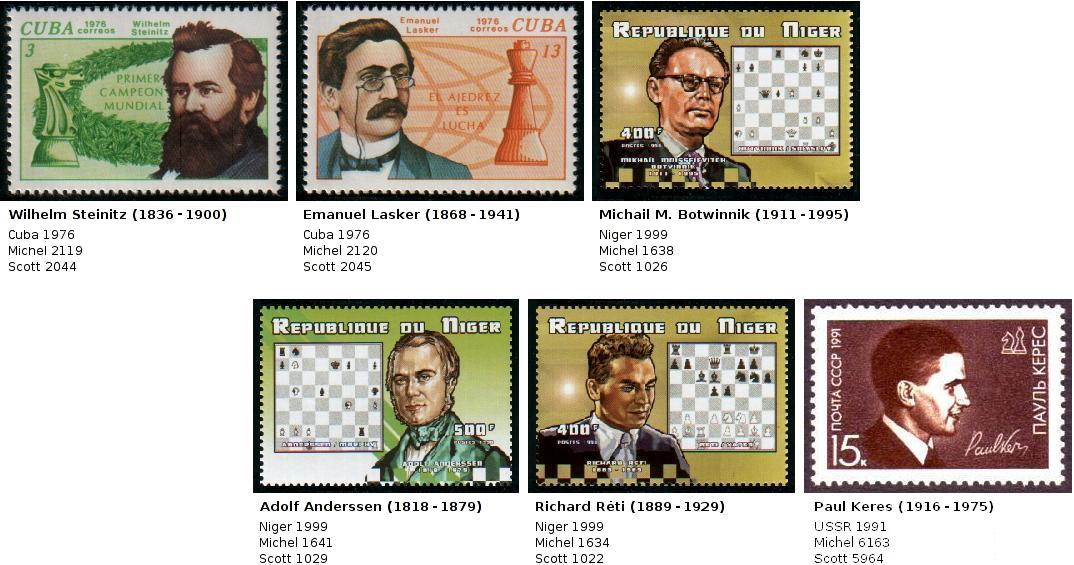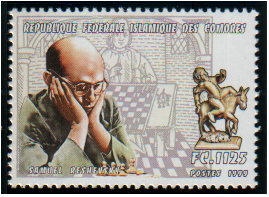 deutsche Version
deutsche Version| Manfred Börgens Mathematics on stamps |
stamp list previous stamp next stamp |
main page |
 deutsche Version deutsche Version |

Chess and Mathematics Part 2 Part 1
Mathematicians as chess masters
Part 1 introduced the mathematician Max Euwe who became world chess champion. There are several other mathematicians who played world-class chess, and three of them became world champions, too. Some of these men do not qualify as mathematicians in a professional sense. I include them for their strong personal connections to mathematics. These connections vary greatly - there are chess masters with academical honours in mathematics as well as those who did not finish their mathematical studies (but not for lack of success, as we shall see). The top row of stamps shows the world champions, the bottom row three other chess masters.
Wilhelm Steinitz (1836 - 1900) World Champion 1886 - 1894
Austria-Hungary, since 1888 USA
Chess
In Prag where he grew up Steinitz was one of the best chess players since his early youth. In 1866, he defeated Adolf Anderssen in London who was believed to be the best chess player of his time. It took 20 years from then till the first world championship match was organized in several US cities. Steinitz defeated his Polish challenger Jan Zukertort. He defended his title three times and kept it for eight years. In 1894, he lost the world championship against Emanuel Lasker. Steinitz also was editor and author for chess magazines and published, in 1889, the Modern Chess Instructor in which he explained his "modern school". The principles laid down in this book later became widely accepted but were rejected by many of Steinitz' contemporary colleagues.
Mathematics
Wilhelm Steinitz studied mathematics at Wien Polytechnic since 1858. He broke off his studies because he was too poor to pay the fees. Then he decided to become a professional chess player.
Emanuel Lasker (1868 - 1941) World Champion 1894 - 1921
Germany
Chess
In 1889, Lasker started a career as a successful chess tournament player. He became the second world champion and managed to keep the title for 27 years, from his victory against Steinitz in the USA until his defeat against Capablanca in Havanna; in this period, he defended the title five times. Lasker was editor and author for chess magazines, too. In 1925, he published Lehrbuch des Schachspiels (Textbook of Chess) in which he further developed Steinitz' principles.
Mathematics
From 1889 until 1891, Emanuel Lasker studied mathematics in Berlin and Göttingen. Then he interrupted his studies and worked as a professional chess player. Only three years later, he became world champion. But from 1895 on, he participated in very few tournaments because he wanted to devote his time to mathematics again. From 1897 until 1899, he studied in Heidelberg and Berlin; thereafter, he prepared his doctorate. In 1901, he was lecturer for mathematics at the University of Manchester. In 1902, he gained his doctorate at the University of Erlangen; his dissertation Ueber Reihen auf der Convergenzgrenze had been published in the Philosophical Transactions of the Royal Society of London in 1901. In 1905, his paper Zur Theorie der Moduln und Ideale appeared in Mathematische Annalen. This paper was so important that a commutative ring whose ideals are finite intersections of primary ideals is called a "Lasker-Ring". Late in his life, Lasker was honoured by an invitation of the Moscow Academy of Science and lived as a member of the Academy in Russia in the years 1936 and 1937.
Mikhail M. Botvinnik (1911 - 1995) World Champion 1948 - 1957, 1958 - 1960, 1961 - 1963
Russia, Soviet Union
Chess
In 1948, the successor of Alexander Alekhine - who had died while holding the title - was determined by a tournament in Den Haag and Moscow. Botvinnik defeated his four opponents by a large margin. He defended this title twice until 1957. Then an unparalleled series of world championship matches followed. In 1957 and in 1960, Botvinnik lost against Vasily Smyslov and Mikhail Tal, resp., but both times he won the rematch in the following year already. It was not before 1963 that Mikhail Botvinnik's presence in the world championships ended with his defeat by Tigran Petrosian.
Mathematics
Of all chess masters who are portrayed here, Mikhail Botvinnik probably has the weakest connection with mathematics. But at any rate, in 1991, the Faculty of Mathematics of the Italian University of Ferrara awarded him an honorary doctorate. Botvinnik was an electrical engineer, holding a Ph.D, and continued to work in his profession during his chess career. He retired from playing tournament chess in 1970 and from this time did research in Artificial Intelligence. Botvinnik was a pioneer in the field of chess software.
Adolf Anderssen (1818 - 1879)
Germany
Chess
In 1851 the World Exposition in London ("Great Exhibition of the Works of Industry of All Nations" in Crystal Palace) staged a chess tournament with 16 European chess masters. The winner was Anderssen, until then unknown to most of the chess world. It was not before 1858 that he met the best American chess player of that time, Paul Morphy, in Paris, and was defeated by him. Soon after that match, Morphy resigned from playing tournament chess and Anderssen was considered the best active chess player from 1859 until 1866 when he lost against Steinitz in London.
Mathematics
Anderssen studied mathematics at the University of Breslau and worked as a high school teacher for mathematics. In 1865, the university awarded him an honorary doctorate and the title of professor.
Richard Réti (1889 - 1929)
Austria-Hungary, later Czechoslovakia
Chess
Réti was one of the most successful chess players in the 1910s and 1920s. In 1924, he defeated world champion Capablanca in a tournament in New York - it was Capablanca's first defeat after eight years. He was author of the books Die neuen Ideen im Schachspiel (New ideas in the chess game) and Die Meister des Schachbretts (Masters at the chess board). Richard Réti composed a famous chess problem which can be found on a problem page of this website.
Mathematics
Réti studied mathematics in Vienna. One day he left his seminar paper in the Café Central; when he came back to collect it, it was gone. Spontaneously, he decided to give up his studies and become a professional chess player.
Paul Keres (1916 - 1975)
Estonia and Soviet Union
Chess
Keres was three times chess champion of the Soviet Union. Several times he was runner-up by a narrow margin in the world championship candidates tournaments. There appear to be hints in KGB documents recently made public that Keres' chess career was hampered by the Soviets who put pressure on him to throw games against other Soviet players at international tournaments. Keres wrote several books on chess, among these The Art of the Middle Game and Practical Chess Endings.
Mathematics
Paul Keres studied mathematics at the University of Tartu from 1937 until 1941.
Other stamps
As chess is a favourite subject on stamps, one can find lots of stamps showing the six chess masters above. I found only two stamps of Keres and only one of Réti, but the other four men are very popular on stamps.
I wonder if there are readers who would advocate Samuel Reshevsky (1911 - 1992) to be included in the list of chess masters with a connection to mathematics. According to most sources Reshevsky obtained a degree in accountancy from the University of Chicago in 1933. There is a stamp honouring Reshevsky issued by the Comoro Islands.

Comoro Islands 1999 Scott # 960